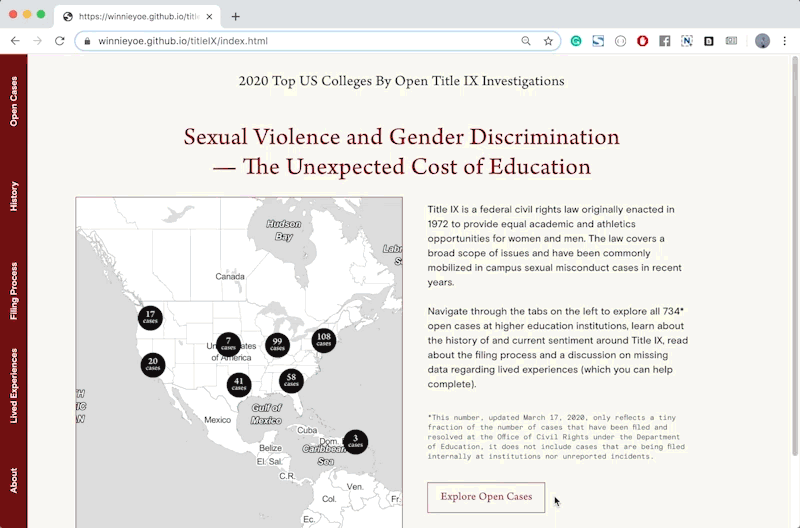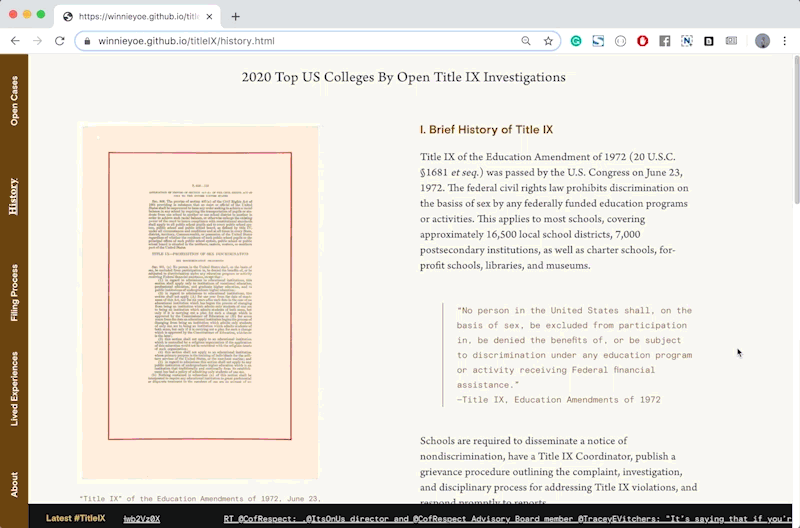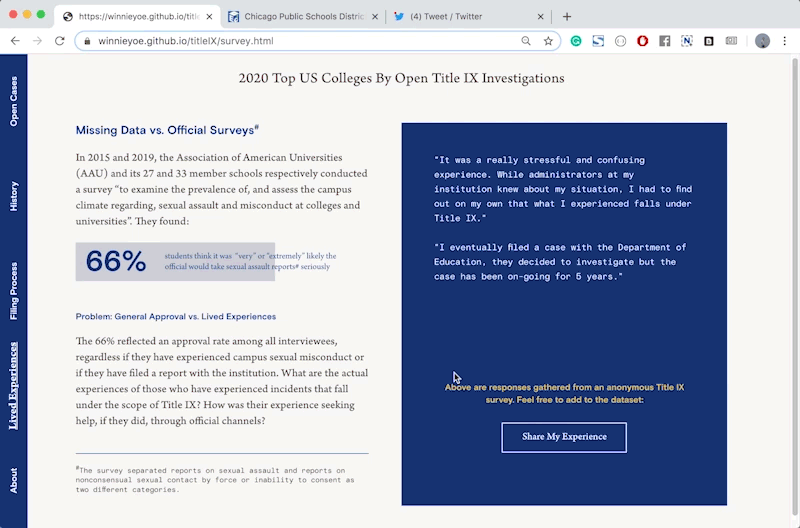Beyond Case Closed: 2020 Top US Colleges
A Web-based Title IX Resource Guide to Empower Survivors & AdvocatesOverview
How can we build resilience facing traumatic and complex scenarios, especially when traditional means of protest are not feasible?
2020 US Top Colleges By Open Title IX Investigations is a web-based resource guide with map visualization, dynamic updates, and real-time database developed to support college campus sexual violence survivors and raise awareness about the process of Title IX investigations.
The project is driven by my experience filing a Title IX complaint and reflecting on the limitations of procedural measures in seeking social justice.
︎ Explore Live Site
2020 US Top Colleges is one of the three projects included in my ITP thesis.
︎ Explore Thesis Projects
︎ View Thesis Presentation
How can we build resilience facing traumatic and complex scenarios, especially when traditional means of protest are not feasible?
2020 US Top Colleges By Open Title IX Investigations is a web-based resource guide with map visualization, dynamic updates, and real-time database developed to support college campus sexual violence survivors and raise awareness about the process of Title IX investigations.
The project is driven by my experience filing a Title IX complaint and reflecting on the limitations of procedural measures in seeking social justice.
︎ Explore Live Site
2020 US Top Colleges is one of the three projects included in my ITP thesis.
︎ Explore Thesis Projects
︎ View Thesis Presentation
Role
Concept, Interaction & Visual Design, Development
Tools
JavaScript, HTML/CSS, Leaflet.js, Puppeteer.js, Python, Selenium, DataTables.js, Figma, Adobe Photoshop
Concept, Interaction & Visual Design, Development
Tools
JavaScript, HTML/CSS, Leaflet.js, Puppeteer.js, Python, Selenium, DataTables.js, Figma, Adobe Photoshop
Context
Title IX is a federal civil rights law originally enacted in 1972 to provide equal academic and athletics opportunities for women and men. In recent years, it has been commonly mobolized in campus sexual misconduct cases.
While Title IX has been introduced for over 40 years, from my personal experience and interviews with survivors and advocates, information about the progress of filing complaints still lacks transparency, and reports are often mishandled.
Recent Development
In March 2020, as I was finishing building this project site, Education Secretary Betsy DeVos released new Title IX regulations, many of which struck back survivors’ rights.
Title IX is a federal civil rights law originally enacted in 1972 to provide equal academic and athletics opportunities for women and men. In recent years, it has been commonly mobolized in campus sexual misconduct cases.
While Title IX has been introduced for over 40 years, from my personal experience and interviews with survivors and advocates, information about the progress of filing complaints still lacks transparency, and reports are often mishandled.
Recent Development
In March 2020, as I was finishing building this project site, Education Secretary Betsy DeVos released new Title IX regulations, many of which struck back survivors’ rights.
Process: Data Source, Web Scraping, Photoshop Batch
Title IX is a federal civil rights law originally enacted in 1972 to provide equal academic and athletics opportunities for women and men. In recent years, it has been commonly mobilized in campus sexual misconduct cases.
Data for open Title IX Investigations are gathered from the Office of Civil Rights' "Pending Cases Currently Under Investigation at Elementary-Secondary and Post-Secondary Schools as of March 17, 2020, Search" (View Link). Only data from post-secondary institutions are used in this project.
Tuition, the institutions' physical location is scraped from Google Searches using Puppeteer.js. Promotional images for each institution are scraped with a Python script using Selenium. Images are blurred using due to ethical reasons. After processing and cleaning the data, I compiled and formatted it into a GeoJSON file for visualization.
Prototype
To understand the data, I first created a prototype to filter all currently open Title IX investigations at higher educational institutions by different categories. I co-opted the language of U.S. Top colleges ranking lists that are published every year. The outcome was informative, but not very engaging and feels very cold.
︎ Explore Prototype
Userflow

Interviews
I conducted interviews for feedback over Zoom and email. Many of these feedback informed my design and framing decisions:
- Added survey component
- Redesigned visual
- Added disclaimers and reframe project to clarify that the data does not represent a full picture
- Added intro page for context
- Blurred scraped photos for privacy concerns

Components
1. Open Cases
Map visualization of all currently open Title IX investigations at higher educational institutions. Schools are ranked in the number of total open cases, in descending orders. Details regarding the cases by clicking the school or the individual marker on the map.
Map visualization of all currently open Title IX investigations at higher educational institutions. Schools are ranked in the number of total open cases, in descending orders. Details regarding the cases by clicking the school or the individual marker on the map.

2. History
Brief history and recent development of Title IX, with archival images.
Live update of latest #TitleIX related tweets are displayed at the bottom of the page and are linked to the specific tweet.
Brief history and recent development of Title IX, with archival images.
Live update of latest #TitleIX related tweets are displayed at the bottom of the page and are linked to the specific tweet.

3. Filing Process
Information about the process of filing a Title IX complaint, and common mishandlings supported with OCR investigation results and court case documents.
I created diagrams and flow charts to visualize the thought process and filing process. I chose to use supportive language, reminding viewers it is also ok to not file a case and it is important to take care of themselves.
Information about the process of filing a Title IX complaint, and common mishandlings supported with OCR investigation results and court case documents.
I created diagrams and flow charts to visualize the thought process and filing process. I chose to use supportive language, reminding viewers it is also ok to not file a case and it is important to take care of themselves.

4. Missing Data
In 2015 and 2019, the Association of American Universities conducted surveys to access campus climate regarding sexual misconduct. While they evaluated students' confidence in their institutions, it did not reflect survivors' lived experiences. This survey is set up to fill that missing data, once completed, results from a real-time database is visualized to reflect a collective sentiment.
In 2015 and 2019, the Association of American Universities conducted surveys to access campus climate regarding sexual misconduct. While they evaluated students' confidence in their institutions, it did not reflect survivors' lived experiences. This survey is set up to fill that missing data, once completed, results from a real-time database is visualized to reflect a collective sentiment.

5. About
Write up of methodology, references, and data sources.
A compiled JSON file of all open Title IX investigations is available for viewers to download and explore the data.
Write up of methodology, references, and data sources.
A compiled JSON file of all open Title IX investigations is available for viewers to download and explore the data.

Credits
This project would not have been possible without the generous help and adivce from Mimi Onuoha, Marina Zurkow, Genevieve Hoffman, David Rios, Sukanya Aneja, Mark Lam, Jaekook Han, Emily Lin and Louis Wheatley.
This project would not have been possible without the generous help and adivce from Mimi Onuoha, Marina Zurkow, Genevieve Hoffman, David Rios, Sukanya Aneja, Mark Lam, Jaekook Han, Emily Lin and Louis Wheatley.
